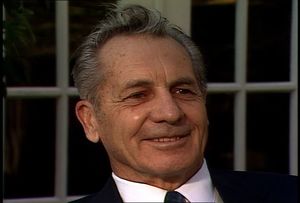Interview with Gerry Miller, 1986
Item Information
- Title:
- Interview with Gerry Miller, 1986
- Description:
-
Admiral Gerry Miller was a Strategic Planner for the U.S. Navy beginning in the 1950s. He starts the interview by discussing the push within the military services to acquire a nuclear weapons delivery capability because "that's where all the dollars were going." The competition over the Polaris missile was particularly intense between the Navy and the Strategic Air Command (SAC), he recalls, and he provides colorful recollections of Admiral Arleigh Burke's reactions after losing the fight to the Air Force, as well as of his (Adm. Miller's) subsequent transfer to Omaha as a Navy liaison officer to SAC. He discusses SAC's role in generating a highly overblown Soviet threat estimate at the beginning of the 1960s, including running a war game that assumed "an astronomical threat." Other commentary relates to the complex task of nuclear planning, an area subject to a great deal of individual interpretation, especially with respect to the overall guidance provided to the planners from higher authorities. Related topics covered in the interview are the level of destructive capacity sought in U.S. plans, the penchant for building up numbers of weapons, and the relative effectiveness of those weapons. He states unequivocally that the U.S. could have managed strategically with far fewer weapons in the 1950s, and he hints that President Eisenhower could have done more to impose limits had he wanted to do so. Speaking in more detail about the planning process, he illuminates some of the core concepts of targeting and why planners believe so many weapons are needed in certain circumstances. Contrary to some critics, he insists that even the early SIOPs contained options beyond massive strikes.
- Interviewee:
- Miller, Gerry
- Date:
-
March 25, 1986
- Format:
-
Film/Video
- Location:
- WGBH
- Collection (local):
-
WGBH Open Vault
- Series:
- War and Peace in the Nuclear Age
- Subjects:
-
Nuclear weapons
United States. Joint Chiefs of Staff
United States. Army
Intercontinental ballistic missiles
Massive retaliation (Nuclear strategy)
Targeting (Nuclear strategy)
Soviet Union
North Atlantic Treaty Organization
Mutual assured destruction
Schlesinger, James R.
Photographic reconnaissance systems
U-2 (Reconnaissance aircraft)
United States. Air Force. Strategic Air Command
United States. Navy
United States. Dept. of Defense
Polaris (Missile)
Rathjens, George W.
Counterforce (Nuclear strategy)
Photographic interpretation
Nuclear warfare
United States. Air Force
United States. Marine Corps
Ford, Gerald R., 1913-2006
McNamara, Robert S., 1916-2009
Enthoven, Alain C., 1930-
Power, Thomas S. (Thomas Sarsfield), 1905-1970
Eisenhower, Dwight D. (Dwight David), 1890-1969
Kistiakowsky, George B. (George Bogdan), 1900-1982
Burke, Arleigh A., 1901-1996
Kennedy, John F. (John Fitzgerald), 1917-1963
Norstad, Lauris, 1907-1988
Kent, Glenn A., 1915-
- Places:
-
China
United States
Cameroon > North (region)
- Extent:
- 00:50:54:29
- Link to Item:
- https://openvault.wgbh.org/catalog/V_D7C6148C8E9E49E6BAA91449F2DAE608
- Terms of Use:
-
Rights status not evaluated.
Contact host institution for more information.
- Publisher:
-
WGBH Educational Foundation
- Identifier:
-
V_D7C6148C8E9E49E6BAA91449F2DAE608




